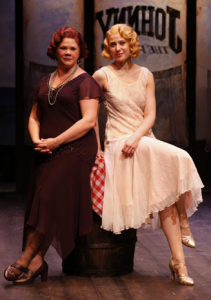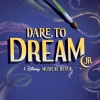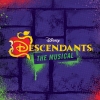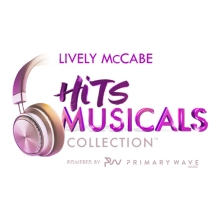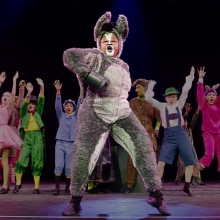Filichia Features: Old Girl in Town
Filichia Features: Old Girl in Town
There’s a lot of life in the New Girl yet.

New Girl in Town, that is, the 1957 musical of Eugene O’Neill’s Anna Christie. It was a hit in its day and ran over a year, and yet, we don’t see many productions of it.
So we must take our hats off to Charlotte Moore, the artistic director of The Irish Repertory Theatre. She not only chose to revive the 55-year-old show, but directed it, too. In the process, she proved that the George Abbott-Bob Merrill show still has a great deal to offer.
Moore may very well inspire others – including you – to give the old Girl a try.
Have you a small space that can’t accommodate a big musical? The Irish Rep production proves that New Girl reduces well. Its stage isn’t much bigger (and perhaps smaller) than many a suburban living room.
Because much of the show takes place in Johnny the Priest’s tavern, Moore does have to include the requisite bar. But other than that, she has a couple of barrels function as tables, with a checkered tablecloth atop each. Add a few chairs, and there’s your set. There is a scene on a coal barge, but a virtually bare stage does the trick there.
How ironic that Johnny the Priest’s should be a most unpriestly place. Sailors and their girls – some for hire – call it their home away from home. Two long-time patrons are Chris Christopher (Cliff Bemis), the aging coal barge captain, and Marthy (Danielle Ferland), his long-time lover. Right now, Chris is a little drunk and sloppy, causing Marthy to say “You disgusting creature!” But Moore has Ferland follow it with a big, beaming smile that shows that she really loves him, too. You’d be wise to include this in your production.
Marthy’s about to get some competition for Chris’ affection. She won’t quite be “the other woman” in the usual context; she’s Anna (Margaret Loesser Robinson), the daughter he sent to live with relatives when she was five. Now, after all these years, Anna has written to say that she’s coming for a visit.
Chris is so afraid that when his daughter meets him, she’ll think he’s nothing but a lush. He sings “Anna Lilla,” a tender song in which he remembers that adorable little girl.
Little does Chris know that Anna is more afraid of what he’ll think of her -- for she’s been working not as a nurse, as she’s claimed, but as a lady of the evening.
Chris isn’t around when she enters, but Marthy is there to hear Anna’s opening line that often shows up in famous movie quotations: “Gimme a whiskey – ginger ale on the side. And don’t be stingy, baby.”
So this is hardly Daddy’s Little Girl – not that Chris can see it. How sad and touching when Chris comes in, sees his grown daughter – and takes off his hat out of respect. It’s not in the script, but Moore is smart to add it here. Remember this too when you do the show.
Anna tries to inform her father that she’s no Little Mary Sunshine in “On the Farm,” a solid song in which she obliquely tells of growing up and being sexually abused at the hands of her older male relatives. Still, Chris chooses to be in denial.
Soon Anna is living with Chris on his barge. During a terrible storm, they save a sailor who falls from his boat. He’s Mat, and when he sees Anna, he idealizes her, too. It’s close to love at first sight for him, which can happen when a man has been at sea for four months. In a different context, Mat will be at sea regarding her for some months more.
Chris is furious and fearful that his darling little girl will wind up with the likes of a sailor. Little does he know that of the two lovers, Mat is the more innocent.
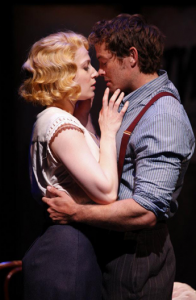
'New Girl In Town' at The Irish Repertory Theatre, Margaret Loesser Robinson and Patrick Cummings
Perhaps too innocent. Don’t sailors know all about women? Moore was wise in the way she cast Mat. She chose Patrick Cummings, a recent graduate from Carnegie-Mellon. Thus, he’s around 17 years younger and less experienced than Charles Bickford was in the 1930 film of Anna Christie and George Wallace in the original New Girl in Town; each of them was approaching his 39th birthday.
In both cases, audiences must have wondered why these experienced guys couldn’t see that Anna was no madonna. When you’re casting your production, you’d be well-advised to follow Moore’s lead and choose a young actor who can play naïve without looking silly. Cummings does just that.
Eliza Doolittle was famous for dropping her “h’s.” Moore decided that Patrick Cummings should add one – in the song that Merrill called “Look at ‘er.” Cummings sings “Look at Her,” and, frankly, it sounds better and more natural. (Merrill has a nice turn of phrase here; the song doesn’t just have Mat urge others to “look at her,” but at the end, he decides that “the reason I have eyes is just to look at her.”)
So he’s smitten, but given Anna’s background, she’s more than a little reluctant to fall in love. She even jumps at Mat’s touch. Still, “It’s Good to Be Alive,” she sings plaintively. Merrill’s song is quite pretty, and Abbott, who directed, knew it, because he had Mat reprise it later.
Mat is ready to prove his love by getting a tattoo of her name on his arm. This may cause many thirtysomething theatergoers to wince, as they look at their own 10-year-old tattoos that they now wish would disappear.
But a tattoo with a woman’s name would be much worse for a lovesick man who doesn’t know everything about the woman he ostensibly loves. Anna tries to tell him the truth about her, but can’t find the courage. So Mat gets the tattoo.
His “official” proclamation of love spurs Anna to say “I ain’t never loved a man in my life before.” Yes, she’s exercising a loophole. She’s not saying that she’s never been with another man, mind you; she’s simply saying that she’s never loved one. And the way that Margaret Loesser Robinson delivers the line, we believe her as we’re supposed to. We see that Anna feels terrible about misleading Mat, but she knows the truth will drive him away. To paraphrase a line from Fiddler on the Roof: “Isn’t a poor working girl entitled to some happiness?”
Abbott also loved to create scenes where people had an excuse to sing and dance: among many others, the union fundraiser in The Pajama Game; The Joe Hardy Appreciation Day in Damn Yankees. Here, it’s the Check Apron Ball, the big event of the season for these folks. Original choreographer Bob Fosse even got in a little more dancing by having Anna and Mat practice for it. (Of course, Gwen Verdon was in the original production, so theatergoers relished the extra chance to see her dance.)
At the ball, Moore has her entire cast of 10 join in. If you’re concerned that you don’t have polished enough dancers for your production, worry not. “At the Check April Ball” almost depends on non-dancers, because the fun of it is seeing worn-out characters suddenly finding the energy to do a few steps. Of course, if you have good dancers who can impress, they’ll be appreciated by your audience as well.
The Irish Repertory Theatre, Danielle Ferland & Margaret Loesser Robinson
New Girl In Town employs musical theater’s favorite secret weapon: show your characters at the height of their happiness – and then deliver information that devastates them. Here it happens after Anna and Mat express their love in a slow dance. That Anna is wearing the official symbol of innocence -- a white dress – is a red flag for Marthy. She spills the beans, partly because she’s spilled too much liquor into her, but probably more because she can’t stand hearing Chris and Mat constantly state how lovely and innocent Anna is.
If you know the original O’Neill, you’ll find that Abbott changed quite a bit of the ending. In the play, Mat joins a ship that won’t be back for a year. That’ll give him time to think of what he’ll do. In the musical, we see Mat return. He’s still uncertain, but when Chris tells him that Anna has been married in the months that he’s been away, he’s furious that she forgot him so quickly. He’s torn on whether he wants her or not. But Chris is lying, and we get a happy ending.
Merrill’s work shouldn’t just be judged as good for a first Broadway score; it’s wistful when, late in the show Anna sings, “If That Was Love” before coming to the conclusion that “it hurt an awful lot.”
There are some happier songs, too. Marthy gets one with the bargirls as they remember their romantic “Flings” when they were young. Later, when she feels threatened that Anna is taking too much of Chris’ attention, she asks, “Yer My Friend, Ain’tcha?” for validation. Here’s an ideal role for your not-so-young actress who has star presence but a less than glorious voice. (Thelma Ritter played her originally; need we say more?)
“At the Check Apron Ball” has an intoxicating melody, as does “Sunshine Girl” which is supposed to be a popular song from long ago. Midway through, Moore has her chorus nod to each other, as if to say, “Yes, that’s it, that’s the way it went, we’re remembering it right.”
Among Moore’s many smart moves is having saxophonist Stephen Zinnato separate himself from the four-piece band, come on stage and play the scene change music as he walks around following the characters exiting and entering. It works well, because of all the instruments in an orchestra, the sax is the sexiest and all-knowing sounding. Think about it for your production when you bring a New Girl to your town.
Click picture to read all of Peter's articles
You may e-mail Peter at pfilichia@aol.com. Check out his weekly column each Tuesday at www.masterworksbroadway.com and each Friday at www.kritzerland.com. His newest book, Broadway Musical MVPs, 1960-2010: The Most Valuable Players of the Past 50 Seasons, is now available through Applause Books and at www.amazon.com.
